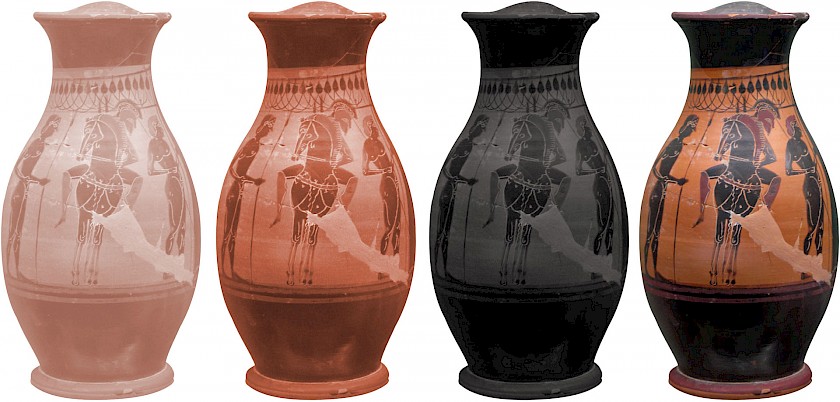The firing process
In ancient Greece, the pottery figure was made in pottery workshops that usually employed a number of people. Some of them would harvest and clean the clay, while potters shaped the vessels and painters decorated them. They were probably family businesses. Sometimes, potter and painter were the same. There are a few vases that depict such workshops. After the painter was done with the vase, it would be left to dry in the open air. A few painters and potters actually signed the vessels that they helped create.
Vessels that were ready to be fired were stacked inside a kiln where temperatures would reach at least 450 degrees Celsius. The conditions inside the kiln were carefully monitored, perhaps by leaving smaller pieces of pottery in a place that was easy to observe or reach through a spy hole. The bright colours and deep blacks of Attic red- and black-figure vases were achieved through a process in which the atmosphere inside the kiln went through a cycle of oxidizing, reducing, and reoxidizing.
During the oxidizing phase, the ferric oxide inside the Attic clay achieves a bright red-to-orange colour. By contrast, clay from e.g. Corinth is paler in colour. During this stage, the temperature inside the kiln reaches perhaps 800 degrees and air is allowed into the kiln through a vent (hence, “oxidizing”, as the air adds oxygen to the atmosphere).
During the reducing phase, the air vent is closed and the temperature is increased to about 950 degrees. Moisture was added in the form of green wood or other damp materials to produce carbon monoxide instead of carbon dioxide. Combined with the ferrix oxide from the clay, the vessel would turn dark grey to black. The finer particles of clay used for the black gloss (i.e. the “paint”) would become sintered or fused as a result, changing permanently, unlike the coarser particles of the vessel itself.

In the final, reoxidizing phase of the firing process, some air was allowed back into the kiln and the temperature was slowly lowered to about 900 degrees. The oxygen turned the more porous reserved clay from gray to a bright orange-reddish colour. Since the earlier reducing phase had sintered the surface of the black gloss, preventing any further chemical reactions and leaving it the desired black colour.
No comments:
Post a Comment